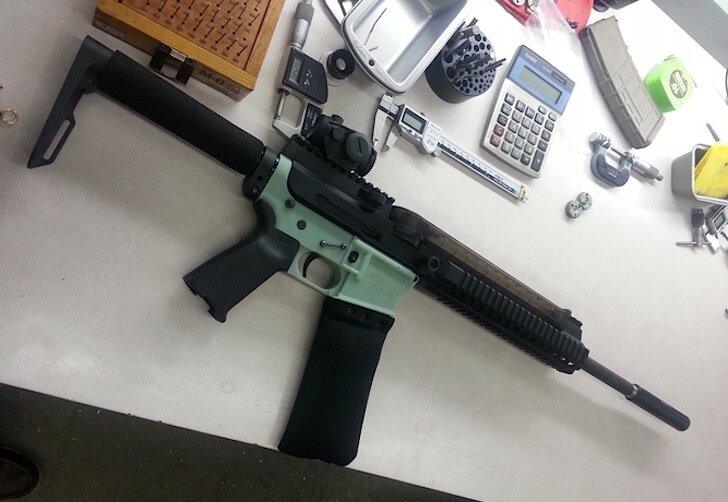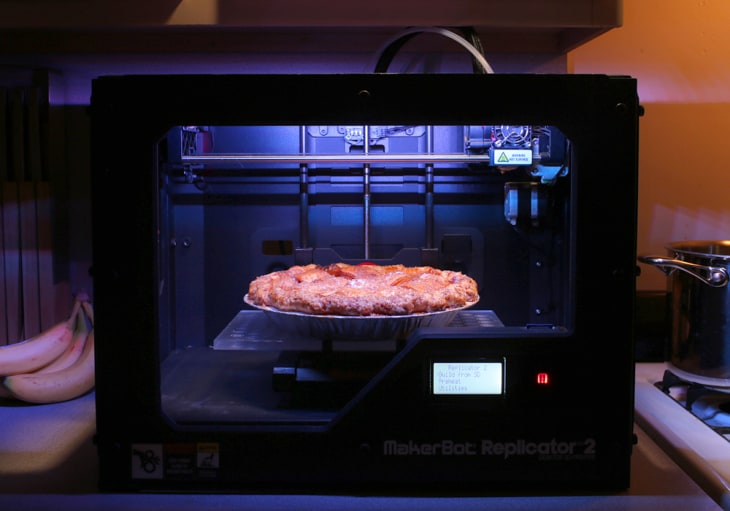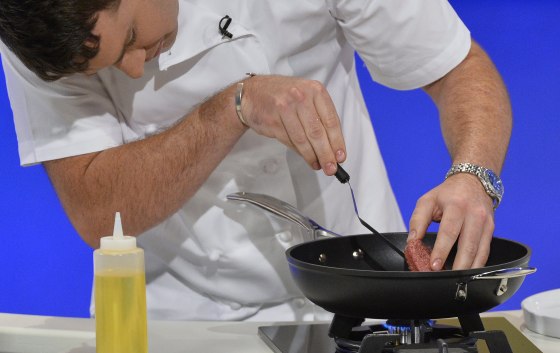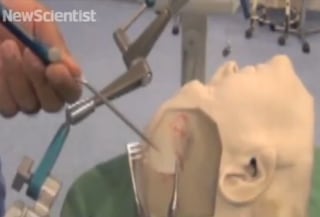Opmmur
Time Travel Professor
- Messages
- 5,049
Guns and garden gnomes: 3-D printer revolution is now

LANCE ROSENFIELD / Redux Pictures
Cody Wilson, who is in the process of developing a gun that will be printed on a 3-D printer, in Austin, Texas.
Addressing a packed auditorium at Austin’s South by Southwest festival last March, Bre Pettis, keynote speaker and co-founder of MakerBot, one of the leaders in desktop 3-D printers, described the increased interest and affordability of his company’s product as heralding the “the next Industrial Revolution.”
"Revolution" is often used even when the result doesn't match the definition — a complete change from the way things were before. Add "Industrial," and the comparison implies not just a change in manufacturing, but society as well, from improved living standards to changes in social class structure. Whether — and how — desktop 3-D printing can bring such changes is much debated, and remains to be seen.
Thanks to companies such as MakerBot, the bulk, expense and technical inefficiency that kept the 30-year-old technology known as Additive Manufacturing — or 3-D printing — confined to major laboratories and factories, is a thing of the past. Now, for less than $3,000, anyone with basic computer skills and an interest in learning more can download and personalize or create a computer-assisted design (CAD) that a printer will fabricate, layer by layer of filament.
Pettis is not the first to make the “next Industrial Revolution” comparison. For some within the maker community — subculture of tech-based do-it-yourself-ers — the increased accessibility of 3-D printer technology means "the end of consumerism.” Conversely, tech analysis firms Gartner predicts that 3-D printing could create opportunities for new product lines created in-house by local retailers. And Daniel Suarez, who spent a decade developing logistics and production planning software for major multinational corporations (and is also a best-selling novelist who writes about near-future technologies) predicts that "3-D printing will be a disruptive economic force in the next two decades — but I also think this disruption will benefit average Americans by causing a resurgence in local manufacturing."
Fervor over 3-D printing’s potential has only increased since SXSW, when Pettis introduced a prototype for the MakerBot Digitizer, which will scan small objects with the end goal of 3-D fabrication. He illustrated the Digitizer’s potential with a projection of a garden gnome, scanned to create … another garden gnome.
For those who don’t so much see an endless supply of home-printed garden gnomes as “revolution,” so much as a shot at getting on A&E’s “Hoarders,” there’s Cody Wilson, the notorious public face of Defense Distributed. Wilson is a University of Texas law student recently licensed to manufacture guns by the Bureau of Alcohol, Tobacco, Firearms and Explosives. In March, Defense Distributed, much to the consternation of gun control advocates, printed the plastic lower receiver for an AR-15 semi-automatic rifle — the portion of a firearm that carries the serial number — which that can fire more than 600 rounds.
Scary, legal and — as Wilson points out — a 3-D printed result that actually does something.

MakerBot
Wilson latched on to Pettis’s garden gnome to express his frustration with the maker community to make something more than geegaws during his riveting yet sparsely attended SXSW presentation about Defense Distributed and DefCAD, an open-source CAD design website he launched after MakerBot’s Thingiverse CAD site dumped all the gun designs from the site following the mass shooting in Newtown, Conn.
A cursory scan on Thingiverse finds a sea of files to create iPhone cases, and myriad holders and stands, but other than clock components, parts to complete a cigar box ukulele, and a theoretical design for a working camera, there isn’t a lot on the open source data base that does stuff.
Wilson is using the platform of 3-D printing to make a political statement about— and push the boundaries of — liberty and the freedom to share information. “I think this isn't a project about firearms, it’s a project about political equality,” Wilson recently told NBC’s Nightly News.
The potential Wilson sees for for 3-D printers isn't just about guns, but prosthetics and other medical devices, even drugs, putting the means of production in the hands of the people.
Pettis and Wilson are often portrayed as polar opposites in the 3-D printer movement, but they both face the inevitable roadblock of all new digital technology — intellectual copyright law.
"When it comes to 3-D printers, groups producing tools, weapons, and reproducing patented or copyrighted objects will be where all the debate and legal fireworks will occur," Suarez told NBC News."Sure, a copyright holder might get upset when individuals reproduce their trademarked cartoon character as little plastic tchotchkes, but I suspect this will follow the same path as digital music and torrented video — namely, there will be several high profile legal cases against perceived infringers until big companies realize technological advances have made this an unstoppable tide."

LANCE ROSENFIELD / Redux Pictures
Cody Wilson, who is in the process of developing a gun that will be printed on a 3-D printer, in Austin, Texas.
Addressing a packed auditorium at Austin’s South by Southwest festival last March, Bre Pettis, keynote speaker and co-founder of MakerBot, one of the leaders in desktop 3-D printers, described the increased interest and affordability of his company’s product as heralding the “the next Industrial Revolution.”
"Revolution" is often used even when the result doesn't match the definition — a complete change from the way things were before. Add "Industrial," and the comparison implies not just a change in manufacturing, but society as well, from improved living standards to changes in social class structure. Whether — and how — desktop 3-D printing can bring such changes is much debated, and remains to be seen.
Thanks to companies such as MakerBot, the bulk, expense and technical inefficiency that kept the 30-year-old technology known as Additive Manufacturing — or 3-D printing — confined to major laboratories and factories, is a thing of the past. Now, for less than $3,000, anyone with basic computer skills and an interest in learning more can download and personalize or create a computer-assisted design (CAD) that a printer will fabricate, layer by layer of filament.
Pettis is not the first to make the “next Industrial Revolution” comparison. For some within the maker community — subculture of tech-based do-it-yourself-ers — the increased accessibility of 3-D printer technology means "the end of consumerism.” Conversely, tech analysis firms Gartner predicts that 3-D printing could create opportunities for new product lines created in-house by local retailers. And Daniel Suarez, who spent a decade developing logistics and production planning software for major multinational corporations (and is also a best-selling novelist who writes about near-future technologies) predicts that "3-D printing will be a disruptive economic force in the next two decades — but I also think this disruption will benefit average Americans by causing a resurgence in local manufacturing."
Fervor over 3-D printing’s potential has only increased since SXSW, when Pettis introduced a prototype for the MakerBot Digitizer, which will scan small objects with the end goal of 3-D fabrication. He illustrated the Digitizer’s potential with a projection of a garden gnome, scanned to create … another garden gnome.
For those who don’t so much see an endless supply of home-printed garden gnomes as “revolution,” so much as a shot at getting on A&E’s “Hoarders,” there’s Cody Wilson, the notorious public face of Defense Distributed. Wilson is a University of Texas law student recently licensed to manufacture guns by the Bureau of Alcohol, Tobacco, Firearms and Explosives. In March, Defense Distributed, much to the consternation of gun control advocates, printed the plastic lower receiver for an AR-15 semi-automatic rifle — the portion of a firearm that carries the serial number — which that can fire more than 600 rounds.
Scary, legal and — as Wilson points out — a 3-D printed result that actually does something.

MakerBot
Wilson latched on to Pettis’s garden gnome to express his frustration with the maker community to make something more than geegaws during his riveting yet sparsely attended SXSW presentation about Defense Distributed and DefCAD, an open-source CAD design website he launched after MakerBot’s Thingiverse CAD site dumped all the gun designs from the site following the mass shooting in Newtown, Conn.
A cursory scan on Thingiverse finds a sea of files to create iPhone cases, and myriad holders and stands, but other than clock components, parts to complete a cigar box ukulele, and a theoretical design for a working camera, there isn’t a lot on the open source data base that does stuff.
Wilson is using the platform of 3-D printing to make a political statement about— and push the boundaries of — liberty and the freedom to share information. “I think this isn't a project about firearms, it’s a project about political equality,” Wilson recently told NBC’s Nightly News.
The potential Wilson sees for for 3-D printers isn't just about guns, but prosthetics and other medical devices, even drugs, putting the means of production in the hands of the people.
Pettis and Wilson are often portrayed as polar opposites in the 3-D printer movement, but they both face the inevitable roadblock of all new digital technology — intellectual copyright law.
"When it comes to 3-D printers, groups producing tools, weapons, and reproducing patented or copyrighted objects will be where all the debate and legal fireworks will occur," Suarez told NBC News."Sure, a copyright holder might get upset when individuals reproduce their trademarked cartoon character as little plastic tchotchkes, but I suspect this will follow the same path as digital music and torrented video — namely, there will be several high profile legal cases against perceived infringers until big companies realize technological advances have made this an unstoppable tide."






